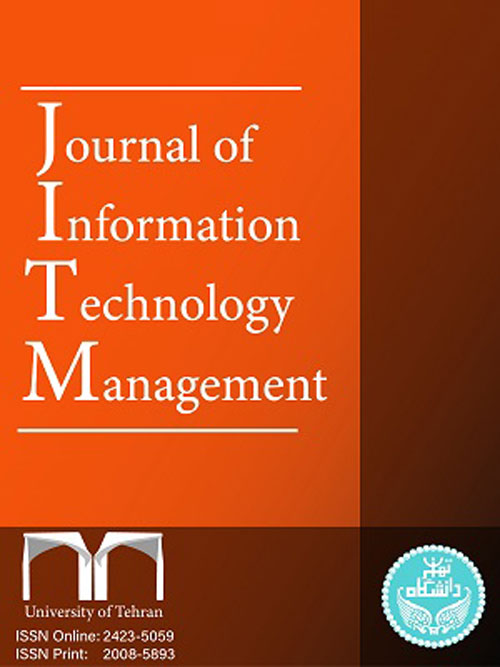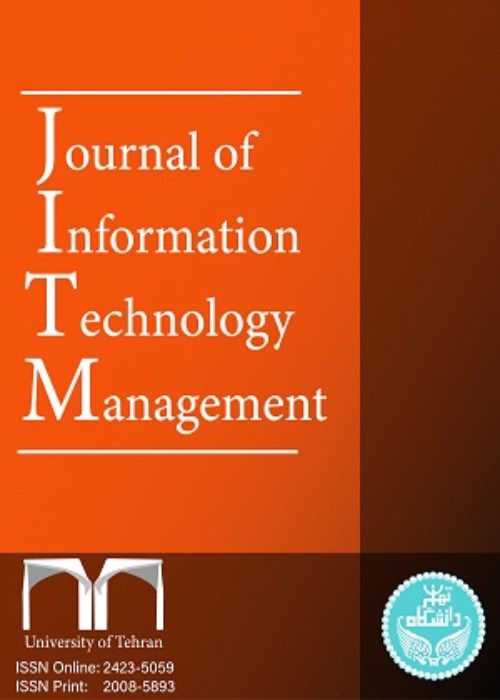فهرست مطالب

Journal of Information Technology Management
Volume:13 Issue: 4, Autumn 2021
- تاریخ انتشار: 1400/07/09
- تعداد عناوین: 8
-
-
Pages 1-15One of the most important risks that the banks and financial institutes face, is credit risk which is related to not-paid instalments or the instalments paid with delay by borrowers. Banks use credit scoring models In order to prevent this type of risk. The goal of this research is to investigate the joint effect of economic time cycles and the industry sector on credit scoring models we are seeking to answer the key question: “when should bank change their credit scoring models based on economic time cycles and for which industry sectors?”. The dataset of the research involves all companies that were applied for a loan in one of the Iranian major banks during the years 2008-2011. The companies have been divided into four industry sectors including “Industry and Mine”, “Oil and chemical”, “Service and Infrastructure” and finally “Agriculture”. Based on the sector of the industry and year, 54 explanatory variables, both financial and non-financial, 12 distinct industry sectors and time-specific data sets are built then classification methods were used to classify customers into two groups of defaults and non-defaults. Finally, we compared the results by Wilcoxon Test. The results show that the companies that are in the groups of Industry and Mine and Agriculture, need their own special credit scoring based on industry type model and time but two other groups don’t need of course in the studies dataset duration. Finally, the study concluded by introducing the credit scoring strategies for different four-cycle of economiesKeywords: Industry sectors, Economic Time Cycles, Credit scoring, Corporate customers, Classification
-
Pages 16-38BackgroundThe Internet of things (IoT) is a new technology that expanding rapidly and has led to the emergence of new services in the banking industry. Although IoT is an emerging technology in Iran, it is expected to become a paradigm in the future. IoT applications in banking have helped to provide high quality and fast responses to customers anytime, anywhere.PurposeThis research aims to identify and prioritize IoT applications in the Iranian banking industry based on business continuity indicators.MethodsFirst, based on the comprehensive literature review and practical experiences, IoT applications in the banking industry are identified. Then, each indicator's weight was calculated using the Grey Decision-making trial and evaluation laboratory (DEMATEL). Finally, IoT-based applications in the Iranian banking industry have prioritized using the multi-attribute utility theory (MAUT). Due to the unstable economic conditions for the financial sector, business continuity indicators are employed in this study. Also, the reason for using MAUT is to consider the utility of banking experts for performing IoT banking services.FindingsAccording to results, IoT-based services in the banking industry, including Transmit instant reports, smart ATMs, non-contact electronic payments, and electronic checks, are identified for Iranian banks. Then, These appropriate services are prioritized with the capabilities of Iranian banks.Keywords: Internet of Things, Smart Banking, Business Continuity Management, DEMATEL, MAUT
-
Pages 39-56The purpose of this research was to identify the skills and abilities learners need in a digital learning environment during the Corona crisis. The research approach was applied in terms of objective and the data collected using the mixed-method approach. In the first part, using a qualitative approach and a document search method, 33 components (related to the skills and abilities of e-learners) were identified, and then19 components out of 33 with the highest frequencies were selected. The target population for this study included all MA students of the University of Tehran who had the experience of studying in an online learning environment, then 374 individuals were selected as a sample using the random sampling method. In the second part, using a quantitative approach and a descriptive-analytical research method, the questionnaire developed by the researcher relies on 19 components identified in the previous step. The experts' opinions proved the validity of the questionnaire—moreover, its reliability in 0.94 (Cronbach alpha). The data was analyzed by SPSS and LISREL, and the results of the data analysis demonstrate that the proposed model is a good fit. Among the 19 components surveyed, all are above average. Finally, the results indicated that the most critical components from e-learners’ view which more critical in digital learning were effective communication, use of the computer, active learning, learning skills, resilience, motivation toward e-learning, emotional intelligence, interaction with e-learning system, self-direct learning, time management, flexibility and adaptability, critical thinking, creativity, asking someone for help, leadership skills, stress management, self-organized, cognitive skills and self-assessmentKeywords: coronavirus, ability, skill, e-Learner, digital learning, University of Tehran
-
Pages 57-115
Considering the organizations’ increasing use of social media, many studies are being conducted in this area. Researchers are faced with a variety of research strategies depending on the nature of the research problem and data. If the right research strategy is not employed, the researcher will lose focus, and the time and effort spent will not necessarily serve the research objectives. When choosing a research strategy, the organization’s characteristics should be taken into consideration; otherwise, it may lead to confounding interpretations of the findings. In this regard, the present study aims to introduce an appropriate research strategy for each maturity stage of the organization under study. To this end, using systematic mapping methodology, about 256 articles published within 2011- 2021 were investigated, and the relationship between the types of research strategy used and the different stages of an organization’s maturity in using social media was reported. Specifically, by synthesizing the social sciences research methodology framework and the social media stage of the growth model, a mapping was developed between the research strategies and maturity stages. Based on this mapping, it is expected that the appropriate strategy for research at the first maturity stage is exploratory, and for the second and third stages are observational and descriptive, respectively. When the organization moves to the fourth and fifth levels, archival and causal strategies are recommended for research. Using the results of this research, researchers will be able to identify the right research strategy for the maturity stage of the organization under study and develop the appropriate research design accordingly.
Keywords: Social media, Stages-of-growth, Research strategy, Conceptual map, Literature Review -
Pages 116-125SCImago Journal Rank (SJR) is one indicator of a journal's reputation. The value is calculated based on several published journals, such as scholarly journals' scientific impact, representing the number of quotes sent to a journal and the relevance or reputation of journals from which the quotations originate. A high SJR value means that the corresponding journal has a high reputation. This study aims to approach the SJR classification by implementing a machine learning approach. A simple yet powerful method Naïve Bayes Classifier (NBC), is selected. NBC utilizes probability calculations based on Bayes' theorem. However, NBC has an assumption that the attribute values do not depend on each other. This method is optimized using Particle Swarm Optimization (PSO) to overcome this weakness. This study used SJR data of the computer science domain from 2014 to 2017. Publication without Q rank is filtered for better performance. As a result, the accuracy of the proposed method is higher than the baseline. The use of PSO significantly improves the NBC performance based on the performed T-test. The PSO-NBC selects four of eight features: H index, Cites/ Doc (2 Years), and Ref. / Doc. Overall results show that using PSO-NBC is closer to SJR rather than using mere NBC.Keywords: Naive Bayes Classifier, SCImago Journal Rank, Journal Quartile, Classification
-
Pages 126-143Enterprise Social Media (ESM) has been normally embraced by companies to boost team performance and agility for workers. The goal of this study is to investigate the mediating effect of workplace isolation on the relationships among usage ESM, employee agility and Team Performance along with exploration of the moderating influence of workplace Integrational study model. This research adds to corporate awareness in illustrating the impact of ESM use on team performance and employee agility based on theory of social exchange, theory of information processing and the theory of transactive memory. Cross-sectional survey was employed to collect data from telecommunication firms (public & private). 400 respondents were selected through purposive sampling technique and given close ended questionnaires, 348 questionnaires were selected for further analysis; through a number of statistical tools, after screening out the filled responses. It resulted in Suggesting ESM has a favorable effect on Employee Agility and Team Performance, but the negative relationships were observed among workplace isolation and employee agility and team performance. Further, Workplace Isolation mediated the relationship among ESM, Employee Agility and Team performance. Additionally, Workplace Integration strongly moderated the relationship between ESM and Workplace Isolation. Experts and/or administrators should pay consideration to the impact of using ESM on agility and team performance of the workers. In addition, when implementing ESM to increase team performance they should concentrate on the extent of team diversity. By presenting the relationship between use of ESM, isolation in the workplace, workplace integration, agility of workers and performance of teams; it enriches the ESM use works by exploring the moderating functions of workplace integration while describing the beneficial consequences of workplace integration.Keywords: Enterprise Social Media, Workplace Integration, Workplace Isolation, Employee Agility, team performance
-
Pages 144-160The progression of Internet as a vehicle to penetrate and develop markets is far reached. Advancement in telecommunication and technology are very rapid in Malaysia. Further, the spur is supported and promoted by the government whilst Malaysian’s are receptive to this. However, Malaysian retailers seem to channel much of its turnover through the old avenue. This study is a litmus test on Malaysians awareness on the local apparel sites. Some of the highlighted rationale to shop for apparels online is the experience, convenience and availability. On the flip side, non-user friendly, safety and non-sensory environment are underscored. These variables are analyzed using Chi-Square analysis to test its statistical independence, followed by correlation and further regressed. The research is focused on university students within Klang Valley. There are limited resources to previous studies done on this subject as source of reference. Therefore, further studies can bring forth insights on retailers in Malaysia and the consumer’s behavior; or either one, as the catalyst influence awareness on our local apparel sites. Rhetorical as it may sound, no one is prepared to assume risks in a questionable marketKeywords: Online, Purchase intention, Internet, Technology Model, Innovation
-
Pages 161-182The purpose of this paper is to identify and prioritise mobile wallet (m-wallet) key adoption factors (KAFs). 9 KAFs are proposed by authors on the basis of a systematic literature review. Authors have proposed one novel factor influencing adoption called 'contactless transactions' due to pandemic and new normal post-Covid-19. This has resulted in a total of 10 KAFs. The fuzzy TOPSIS approach is proposed to rank these key adoption factors (KAFs). Sensitivity analysis has also been conducted to check the robustness of the study. Examining the literature indicates that this study is among the first attempts to prioritise key adoption factors (KAFs) using fuzzy TOPSIS. The results show that perceived security, trust, performance expectancy, perceived ease of use and contactless transactions are among the top 5 adoption factors. The findings of this research will be beneficial for both academicians and practitioners. The key adoption factors (KAFs) proposed in the paper will help practitioners develop strategies for building a wider acceptance of m-wallet among customers. Moreover, the fuzzy TOPSIS technique discussed in this paper will apprise managers about critical factors to be focused upon. This study will provide an integrated framework for academicians to carry out further research in the field of mobile wallets.Keywords: Mobile wallet adoption, Key adoption factors (KAFs), fuzzy topsis, Covid-19, New normal


